WATERFALL PUBLISHING HOUSE proudly represents the
following titles :
CONSTRUCTING WALKING JAZZ BASS LINES SERIES
all titles available in print and eBook format with downloadable MP3 playalong backing tracks.
NEW RELEASES MAY 2012
Constructing Walking Jazz Bass Lines Book IV
Building a 12 key facility for the Jazz Bassist

Including over 5hrs of backing tracks 333 tracks in total. Building a 12 key Facility for the Jazz Bassist breaks down the jazz bass vocabulary by outlining key areas of harmonic structure related to the jazz standard and bebop styles. As in the earlier books in the series the lesson material builds in a stepwise manner enabling the student to build on the solid foundational material discussed in books I - III. All lessons are applied to all 12 keys with written out bass lines and 333 MP3 backing tracks applied to 10 jazz and bebop standard chord progressions with over 150 choruses of written out bass line examples. By practicing the material presented in this book, Book I of the series the bassist builds technical facility and expands on their jazz vocabulary by practicing the key harmonic structures used most often by jazz bassists in the jazz standard and bebop styles. Presented in this book and outlined with written out examples in all 12 keys are the fundamentals required by the professional jazz bassist. The II V I in major modulating to II V I in minor Voice Leading The I VI II V over 2 and 4 measures The I VI II V progression and the secondary dominant chord The V of V cycle The I IV III VI progression The bVII Dominant 7th chord & the IV Minor bVII7 progression The IV Minor bVII7 progression The IV Major to IV Minor bVII7 progression Turnarounds into the II IV & VI chords Diatonic chord structures & the II V into the IV chord Bridge Tritone substitution Tritone substitution chord progressions Accents, phrasing & anticipating the chord changes The Minor key tonality & the Minor II V progression The descending Minor II V I Bridge Tritone substitution of the Altered dominant chord. Building a 12 Key Facility for the Jazz Bassist Book II is dedicated specifically to chord and scale studies in 12 keys. Featuring major scale studies and modes, minor scale studies, diminished, wholetone and augmented scales. With written out examples of how to practice the scales, chords and modes in all 12 keys.
Constructing Walking Jazz Bass Lines Book IV
Building a 12 key facility for the Jazz Bassist Bass Tab Edition
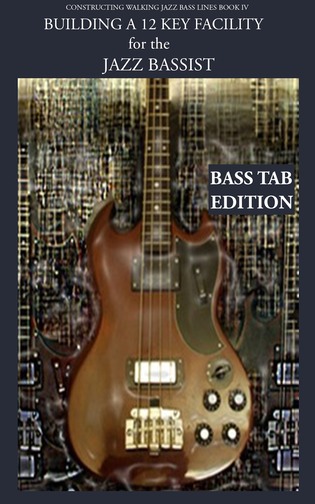
Including over 5hrs of backing tracks 333 tracks in total. Building a 12 key Facility for the Jazz Bassist breaks down the jazz bass vocabulary by outlining key areas of harmonic structure related to the jazz standard and bebop styles. As in the earlier books in the series the lesson material builds in a stepwise manner enabling the student to build on the solid foundational material discussed in books I - III. All lessons are applied to all 12 keys with written out bass lines and 333 MP3 backing tracks applied to 10 jazz and bebop standard chord progressions with over 150 choruses of written out bass line examples. By practicing the material presented in this book, Book I of the series the bassist builds technical facility and expands on their jazz vocabulary by practicing the key harmonic structures used most often by jazz bassists in the jazz standard and bebop styles. Presented in this book and outlined with written out examples in all 12 keys are the fundamentals required by the professional jazz bassist. The II V I in major modulating to II V I in minor Voice Leading The I VI II V over 2 and 4 measures The I VI II V progression and the secondary dominant chord The V of V cycle The I IV III VI progression The bVII Dominant 7th chord & the IV Minor bVII7 progression The IV Minor bVII7 progression The IV Major to IV Minor bVII7 progression Turnarounds into the II IV & VI chords Diatonic chord structures & the II V into the IV chord Bridge Tritone substitution Tritone substitution chord progressions Accents, phrasing & anticipating the chord changes The Minor key tonality & the Minor II V progression The descending Minor II V I Bridge Tritone substitution of the Altered dominant chord. Building a 12 Key Facility for the Jazz Bassist Book II is dedicated specifically to chord and scale studies in 12 keys. Featuring major scale studies and modes, minor scale studies, diminished, wholetone and augmented scales. With written out examples of how to practice the scales, chords and modes in all 12 keys.
STANDARD LINES The Chord Scale relationship method
Book III in the Constructing Walking Jazz Bass Lines
Series. For the Double Bass & Electric Bass
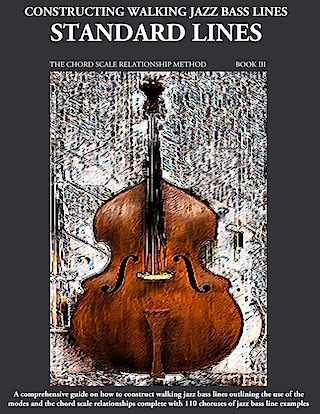
Standard Lines, Book III in the Constructing Walking Jazz Bass Lines series for the Double Bassist and Electric Bassist is a comprehensive guide demonstrating the devices used to construct walking jazz bass lines in the jazz standard tradition. Book III covers 24 standard jazz chord progressions with 110 choruses of professional jazz bass lines as an example. Part I outlines the Modes and the chord scale relationships and the fundamental knowledge required to be able to build the diatonic triads and 7th chords in any key. Examples are given in the " 2 " feel and " 4 " feel walking bass style enabling the bassist to develop a strong rhythmic and harmonic foundation. More advanced bass line construction examples including voice leading and mode substitutions and mode applications related to specific jazz chord progressions are also outlined. Part II outlines the Symmetric Scales as well as the Modes of the Melodic Minor Scale related to the Minor II V I progression. Provided are written examples of the Symmetric Scales and the chord scale relationships and how to apply the use of the Symmetric Scales over popular jazz chord progressions. The Minor II V I is outlined and compared to the Major II V I outlining the differences with the suggested scale uses applied to common jazz chord progressions. Part III outlines the use of the BeBop Scales and their use in the jazz walking bass tradition, providing suggested uses of the Be Bop scales related to popular jazz chord progressions. Part IV outlines the previous lesson devices and concepts with examples of professional level bass lines over standard jazz chord progressions. All information builds in a stepwise progression enabling the bassist to apply the techniques in all 12 keys.
STANDARD LINES The Chord Scale relationship method
Book III in the Constructing Walking Jazz Bass Lines
Series. For the Electric Bass Bass Tab Edition
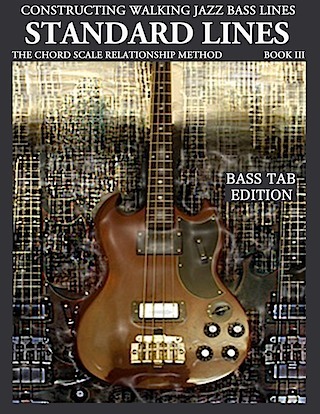
Standard Lines Book III in the Constructing Walking Jazz Bass Lines series for the Electric Bassist is a comprehensive guide demonstrating the devices used to construct walking jazz bass lines in the jazz standard tradition. Book III covers 24 standard jazz chord progressions with 110 choruses of professional jazz bass lines as an example. Part I outlines the Modes and the chord scale relationships and the fundamental knowledge required to be able to build the diatonic triads and 7th chords in any key. Examples are given in the " 2 " feel and " 4 " feel walking bass style enabling the bassist to develop a strong rhythmic and harmonic foundation. More advanced bass line construction examples including voice leading and mode substitutions and mode applications related to specific jazz chord progressions are also outlined. Part II outlines the Symmetric Scales as well as the Modes of the Melodic Minor Scale related to the Minor II V I progression. Provided are written examples of the Symmetric Scales and the chord scale relationships and how to apply the use of the Symmetric Scales over popular jazz chord progressions. The Minor II V I is outlined and compared to the Major II V I outlining the differences with the suggested scale uses applied to common jazz chord progressions. Part III outlines the use of the BeBop Scales and their use in the jazz walking bass tradition, providing suggested uses of the Be Bop scales related to popular jazz chord progressions. Part IV outlines the previous lesson devices and concepts with examples of professional level bass lines over standard jazz chord progressions. All information builds in a stepwise progression enabling the bassist to apply the techniques in all 12 keys.
Other titles in the series
Constructing Walking Jazz Bass Lines Book I Walking Bass Lines - The Blues in 12 Keys
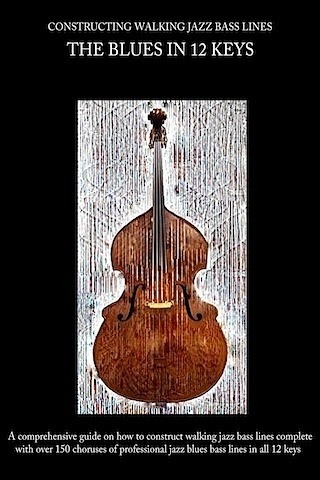
Annotation : CONSTRUCTING WALKING JAZZ BASS LINES BOOK I WALKING JAZZ BASS LINES - THE BLUES IN 12 KEYS UPRIGHT BASS & ELECTRIC BASS METHOD
The Blues in 12 Keys is Book I in the series of Must Know Chord changes for the Jazz Bassist. Outlining the methods used to construct professional level walking bass lines. Covered in the book is jazz bass harmony and theory applied to walking bass lines showing in detail how and why certain methods are used and how they work.
Part 1 by demonstrates the various techniques used to provide forward motion into bass lines, while providing a strong harmonic and rhythmic foundation. The exercises are designed to give the Upright bassist and electric bassist strong jazz bass lines in the bottom register of the instrument. As an added bonus for the Upright Bassist Part 1 provides a complete study of the blues in F whilst in the first position. This is an excellent technique builder in itself. Part 2 expands on the lessons and techniques used in Part 1 providing the bassist with the previous devices used in professional level bass lines in all 12 keys. Included is over 150 choruses of jazz blues lines and jazz blues chord substitutions in all 12 keys using the whole register of the instrument. There are many advanced principles applied in the following bass lines whilst never losing sight of the functioning principle of the bass in the jazz idiom. To provide a strong foundation of rhythm and harmony for the music being played & providing support for the melody and or soloist. Beginner to Advanced levels.
Constructing Walking Jazz Bass Lines Book II Walking Bass Lines - Rhythm Changes in 12 Keys
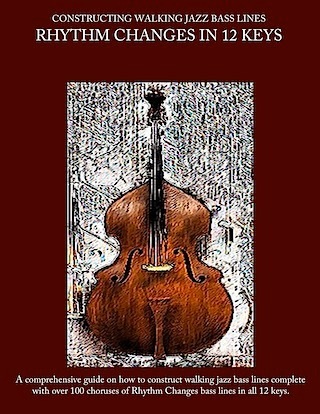
Annotation : CONSTRUCTING WALKING JAZZ BASS LINES BOOK II WALKING BASS LINES - RHYTHM CHANGES IN 12 KEYS UPRIGHT & ELECTRIC BASS METHOD
Rhythm Changes in 12 Keys is Book II in the " Constructing Walking Jazz Bass Lines " series for the Double Bassist and Electric Jazz Bassist.Rhythm Changes in 12 Keys compliments Book I " The Blues in 12 Keys " by following on with an in depth study of " must know " Jazz chord progressions for the aspiring Jazz Bassist. Rhythm Changes in 12 Keys is a complete guide demonstrating how to construct walking jazz bass lines in the jazz tradition.Part 1 of the book outlines and demonstrates the various techniques used by professional Jazz Bassists to provide forward motion and a strong harmonic and rhythmic foundation into bass lines. Part 2 of the book outlines Rhythm Changes in 12 keys with over 70 choruses of professional jazz bass lines. Beginner to Advanced levels.
CONSTRUCTING WALKING JAZZ BASS LINES - TABLATURE SERIES
Constructing Walking Jazz Bass Lines Book I Walking Bass Lines - The Blues in 12 Keys
Bass Tab Edition
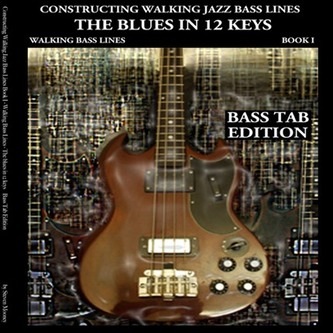
Annotation : CONSTRUCTING WALKING JAZZ BASS LINES BOOK I WALKING JAZZ BASS LINES - THE BLUES IN 12 KEYS BASS TAB EDITION
The Blues in 12 Keys is Book I in the series of Must Know Chord changes for the Jazz Bassist. Outlining the methods used to construct professional level walking bass lines. Covered in the book is jazz bass harmony and theory applied to walking bass lines showing in detail how and why certain methods are used and how they work. Also included are jazz bass lines written out to over 150 choruses of the jazz blues progression, and jazz blues chord substitutions in bass tab and bass clef.
This is an excellent study guide for the electric bassist reading tab enabling them to apply there knowledge of bass tab to the task of reading music. Beginner to Advanced levels.
Constructing Walking Jazz Bass Lines Book II Walking Bass Lines - Rhythm Changes in 12 Keys
Bass Tab Edition
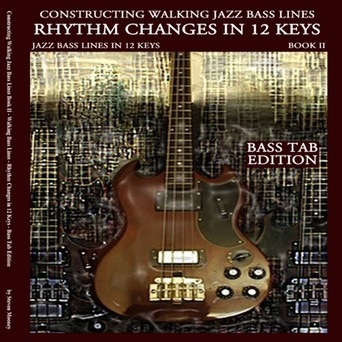
Annotation : CONSTRUCTING WALKING JAZZ BASS LINES BOOK II WALKING JAZZ BASS LINES - RHYTHM CHANGES 12 KEYS BASS TAB EDITION
Rhythm Changes in 12 Keys is Book II in the " Constructing Walking Jazz Bass Lines " series for the Electric Bassist .Rhythm Changes in 12 Keys compliments Book I " The Blues in 12 Keys " by following on with an in depth study of " must know " Jazz chord progressions for the aspiring Jazz Bassist.Rhythm Changes in 12 Keys is a complete guide demonstrating how to construct walking jazz bass lines in the jazz tradition. Part 1 of the book outlines and demonstrates the various techniques used by professional Jazz Bassists to provide forward motion and a strong harmonic and rhythmic foundation into bass lines. Part 2 of the book outlines Rhythm Changes in 12 keys with over 70 choruses of professional jazz bass lines. Beginner to Advanced levels
For more information regarding these titles visit